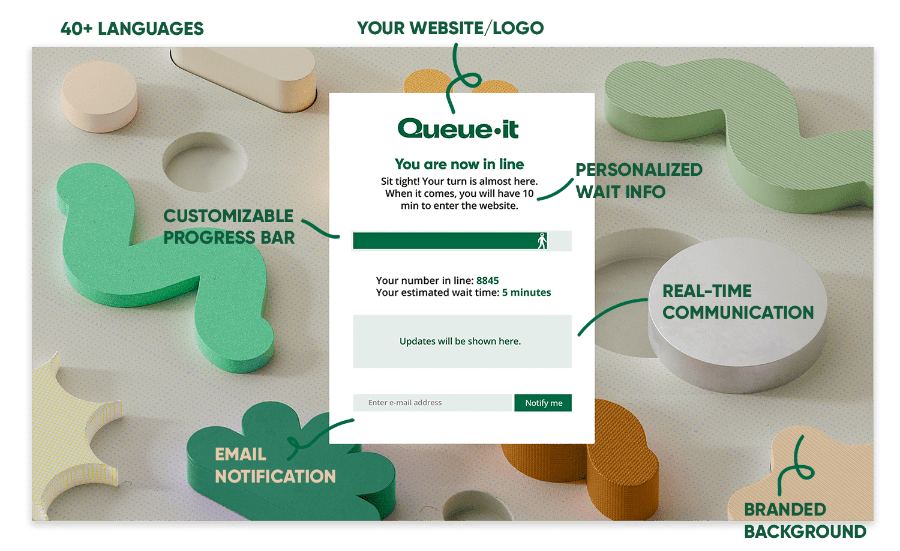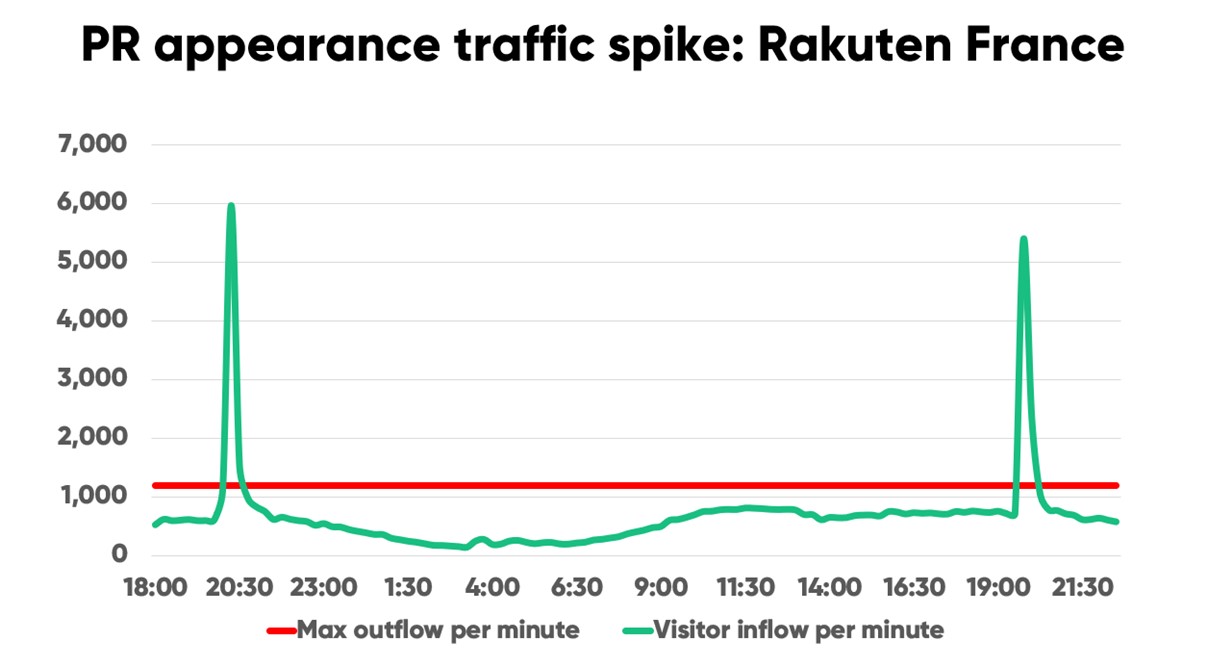How you can turn Super Bowl traffic spikes into success with an online queue

In today’s digital-first world, a Super Bowl TV commercial doesn’t end at broadcasting a message. It will drive a wave of web traffic your website and mobile app. Discover why brands use an online queue system to manage Super Bowl traffic, how the virtual waiting rooms work, and how you can use them to help capitalize on your next big brand moment.
Dubbed “the Oscars of advertising”, the Super Bowl is the most coveted (and expensive) ad slot in the world. It’s not just the 100+ million viewers that make a $7 million, 30-second commercial worth it for brands. It’s the fact Super Bowl ads are a cultural phenomenon—they’re among the few ads people actually get excited to watch.
But an appearance on the world’s biggest stage doesn’t come without challenges. Super Bowl commercials drive massive surges in online traffic to brands’ websites, often causing them to come crashing down.
When faced with large TV appearances like these, many companies keep their site online using a virtual waiting room (also known as an online queue system).
Discover why you would use an online queue system for Super Bowl ads and other large events, how these queues work, and why it’s so hard to keep sites online during massive traffic spikes.
Brands use an online queue or virtual waiting room during major events like the Super Bowl to protect their websites from surging traffic and ensure a smooth and fair user experience.
Many companies learned the hard way that web traffic during Super Bowl Sunday is anything but ordinary. Over the past 20+ years, it’s crashed major websites like:
- Victoria’s Secret in 1999
- 84 Lumber in 2017
- Betting sites FanDuel, BetMGM, and more in 2021
- Coinbase in 2022
These site problems harm sales and frustrate customers on a brand’s biggest day.
If you’d spent millions of dollars and months of work on a major marketing campaign, you’d want to be sure you could capitalize on it, right?
That’s where virtual waiting rooms come in. Virtual waiting rooms let you make the most of your business’s moment in the spotlight by keeping your site online, ensuring fair visitor access, and delivering a seamless customer experience. They can help you:
- Ensure website performance: The virtual waiting room takes the spike in load from the Super Bowl ad and lets you control the flow of customers into your site, ensuring you never exceed the technical capacity of your systems and can sell as fast as possible without crashing.
- Improve customer experience: Virtual waiting rooms replace the frustrating experience of a website crash or slowdown with transparent and controlled access, including detailed info on spot in line and estimated wait time on a branded page that can feature interactive elements like videos or games.
- Deliver fair access: In scenarios like limited-time offers or exclusive product launches often associated with Super Bowl ads, a virtual waiting room provides sophisticated fairness mechanisms like first-come-first-served access or live raffle randomization, ensuring all customers have a fair shot at your offer.
RELATED: The Comprehensive Guide to Virtual Waiting Rooms: All Your Questions Answered
Virtual queues work by automatically redirecting online visitors to a waiting room when they enter a covered part of the user journey, for example visiting a landing page or proceeding to checkout.
Customers are seamlessly flowed from the site to a branded waiting room like the one below, where they see their number in line, their estimated wait time, and a progress bar. From here, they're flowed back to your site at the rate it can handle in a fair, controlled order.

While brands often customize their waiting rooms both in style and in URL to look like the original site, the visitors in them are hosted on the virtual waiting room provider’s servers. This means no strain is placed on the target website’s servers while visitors wait for access.
Let’s look at an example that shows how the virtual waiting room would work during something like a Super Bowl traffic spike.
The French national news is no Super Bowl, but when online retailer Rakuten France appeared on it, their site traffic spiked 819% in two minutes.
“It wasn’t even an ad or offer or anything like that,” says Thibaud Simond, the company’s Infrastructure Manager. “It just said who our spokesperson worked for and mentioned our brand, and immediately we saw a spike.”
Before this news appearance, Simond’s team load tested their site and discovered it could comfortably handle 1,200 visitors per minute before facing issues. They knew from previous experience their web traffic would well exceed this, so they set up Queue-it’s virtual waiting room to protect their site.
When the news segment aired, 6,000 visitors rushed to their site in a single minute—5x more than their site could ordinarily handle.

But instead of this sudden traffic spike bringing the site crashing down, visitors were automatically redirected to a waiting room page. Each visitor got a position in queue and was then flowed back to Rakuten France’s site at exactly the rate it could handle (1,200 per minute).

“Queue-it’s virtual waiting room reacts instantaneously to our peaks before they impact the site experience. It lets us avoid creating a bunch of machines just to handle a 3-minute traffic peak, which saves us time and money … The peace of mind we get from using Queue-it is outstanding.”
Thibaud Simond, infrastructure manager
If an appearance on French national news sent 6,000 visitors to Rakuten’s site, you can only imagine how many of the Super Bowl’s 100,000,000+ viewers visit a brand’s site when their commercial airs.
But the virtual waiting room works in the same way whether the traffic is 600, 6,000, or 6,000,000. It captures any volume of web traffic before it hits the site, then controls the rate at which it flows back to the site, allowing businesses to operate at maximum capacity without crashing.
Break traffic records without breaking your website

They do. But at scale, every system breaks.
There is no “too big to fail” in the world of websites. Amazon, Walmart, Apple, the IRS—surging web traffic has taken all of them offline.
If you’re preparing for a Super-Bowl-level spike, you’ll want to optimize your website in many ways, including scaling your systems.
But scaling alone is expensive at best, and risky at worst.
- Expensive. Most websites are built to perform under their usual amount of traffic. Building a website that can handle huge traffic peaks that only come a few times a year is like buying a house with 10 extra bedrooms and bathrooms because your family comes to visit sometimes—it’s expensive, impractical, and unnecessary.
- Reactive. Because traffic levels are hard to predict and auto-scaling takes time to kick in, your systems likely won’t be ready in the critical moment they’re needed.
- Risky. Even if autoscaling or pre-scaling could handle these surges, bottlenecks almost always emerge. This means traffic still overloads areas that are difficult or impossible to scale, such as databases, inventory management systems, third-party features like payment gateways, and performance-intensive features like dynamic search or a “recommended for you” panel.
A virtual waiting room complements your autoscaling approach and gives you confidence your site will perform by controlling what other crash-prevention tactics can't: the flow of traffic to the site.

"Nobody builds a website to handle hundreds of thousands of people just for a limited amount of time. Throughout the day it’s different, but having that major peak is insane. Queue-it is a great solution that saves the day and it works flawlessly."
ROBERT WILLIAMS, DIGITAL MANAGER
Preparedness is key to making the most of your brand’s biggest days. Whether it’s a Super Bowl ad, a ticket sale, or a product launch, a virtual waiting room solution like Queue-it ensures you’re not only ready for the surge, but also positioned to capitalize on it. You get the confidence knowing your beautiful brand moment won't turn into a technical crisis.
Queue-it is the market leading virtual waiting room solution, having served over 75 billion users across 172 countries. With a mission to deliver online fairness to all, Queue-it empowers the world’s biggest businesses to perform on their busiest days. When Ticketmaster, The North Face, and the State of New Hampshire need to manage high-demand events, they turn to Queue-it. Book a demo today and start preparing for your next high-profile sale or registration.